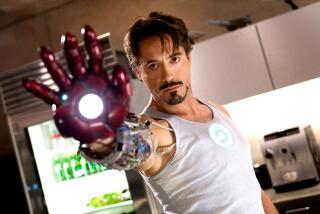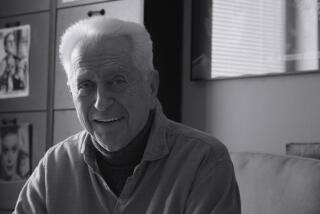Demystifying Sherlock Holmes
- Share via
Forget the deerstalker hat, the twee houndstooth Inverness overcoat and the oversized spyglass. Sherlock Holmes in the 2009 big-budget rendition of Arthur Conan Doyle’s famed detective is most certainly no sexless, stuffy, Edwardian gentleman.
This Sherlock Holmes -- as played by the turbo-speed Robert Downey Jr. -- is a bare-knuckle brawler, a martial arts devotee with a mind that whizzes along like a Ferrari and a penchant for falling into a disheveled slough of depression between cases. And his sidekick, Watson, now embodied by Jude Law, is no neutered, bumbling tag along either, but a military man back from the Afghan wars with a definite taste for mayhem and gambling beneath his ramrod-straight posture. Directing the testosterone-riddled duo is Guy Ritchie, the British filmmaker best known for the kinetic, cartoonish violence promulgated in such gangster films as “Snatch.”
This latest depiction of Holmes is a far cry from the 200 or so previous films based on Conan Doyle’s works, or the 70-plus actors who’ve embodied the detective. Yet producer Lionel Wigram, who came up with the idea for the latest Holmes incarnation, insists their brash Holmes is much more akin to Doyle’s Victorian original.
Wigram began rereading the books several years ago and “my big discovery was that the original stories that were written 120 years ago were more modern than the films that came after it.”
Wigram also brought a modern psychology to Conan Doyle’s hero, noting the antisocial detective most probably had bipolar disorder (the fits of mania followed by weeks of morosely affixing himself to the couch) as well as Asperger’s syndrome, a more high-functioning form of autism. Wigram lists the traits: “his ability to fixate on one particular thing, his rather lacking social skills. He’s not comfortable about people, and he doesn’t read the emotional cues.
“Every single thing we have Sherlock Holmes do comes from the books,” adds Wigram, who often sounds like a walking Holmes encyclopedia, able to annotate which book provided which detail for the movie. This said, the film, which hits theaters on Christmas Day, follows none of Conan Doyle’s stories, which were deemed too small, but presents Holmes battling the ominous Lord Blackwood, a figure inspired by the Victorian occultist Aleister Crowley.
“We live in the world of big event movies. The stakes have to be huge. You have to have an extra supernatural element,” says Wigram.
The screenplay was written by Michael Robert Johnson, Anthony Peckham (“Invictus”) and Simon Kinberg (“Mr. and Mrs. Smith”), who came on during production to modernize Holmes by making him more mischievous and irreverent. “I was looking at Holmes as a prototypical superhero,” Kinberg says. “Before we had Batman or Spider-Man, we had someone who had superpowers, powers of perception unlike anyone else had, and also incredibly flawed vulnerabilities, that most superheroes have as well. We were trying to find ways in the action sequences to dramatize that.”
Toward that end, Downey’s Holmes often pre-visualizes his mode of attack, methodically pinpointing his opponents’ weaknesses in his mind before launching his assault. That was Ritchie’s idea, Kinberg says. “If you’ve seen Guy’s films, it’s a new version of some of the stuff he’s done, speeding up and slowing down the photography,” he says. “That was a big part of giving him modern action but with Holmes’ characteristics.”
--
More to Read
Only good movies
Get the Indie Focus newsletter, Mark Olsen's weekly guide to the world of cinema.
You may occasionally receive promotional content from the Los Angeles Times.









